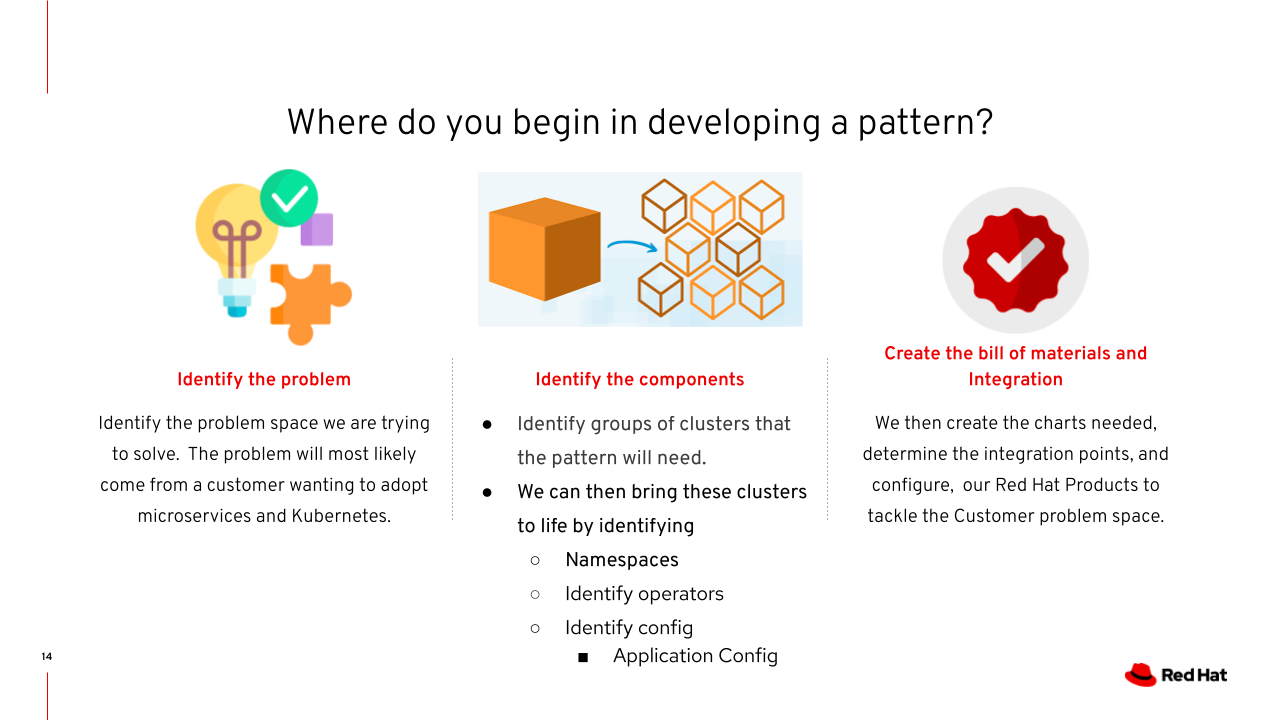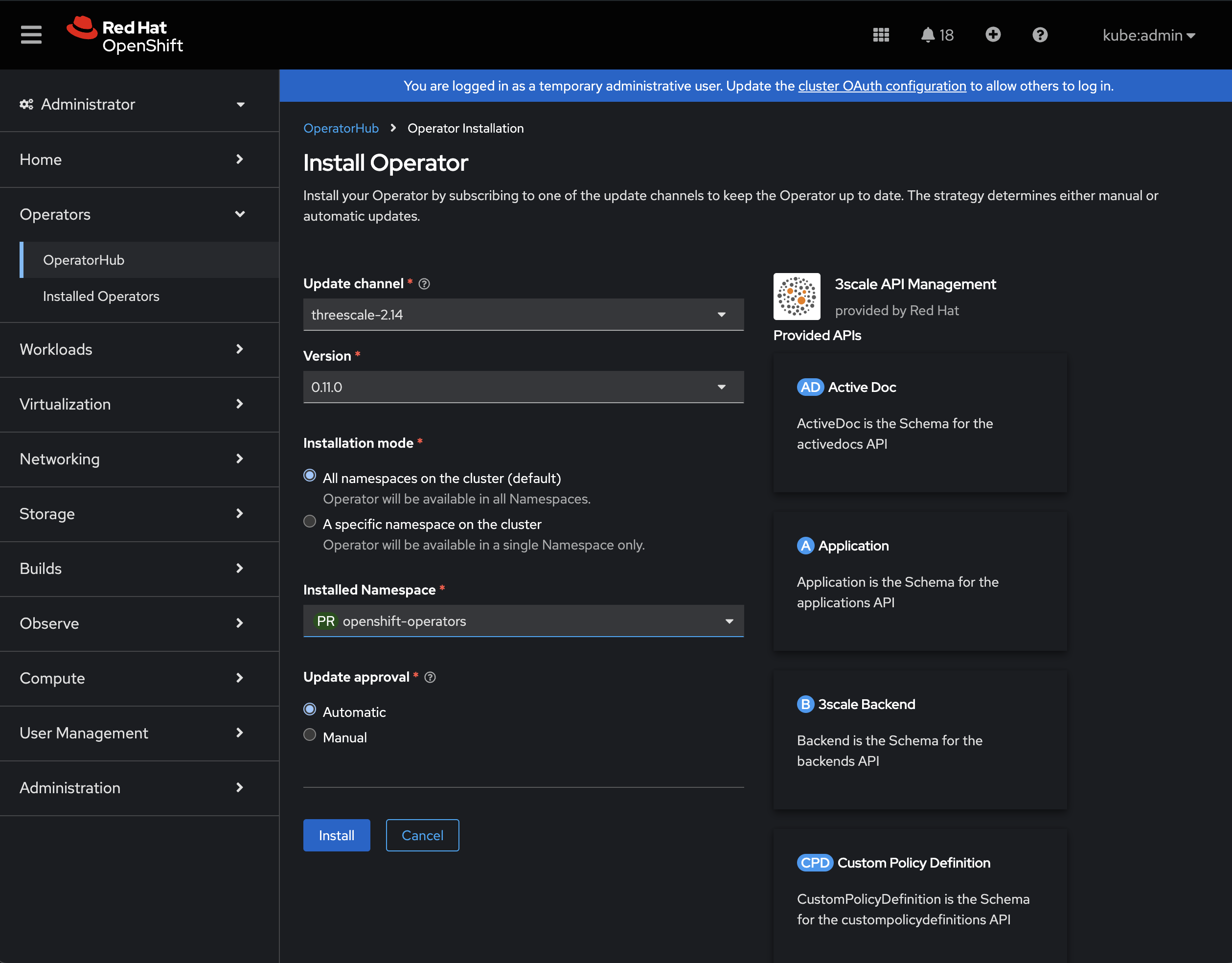Topic Objectives
In this topic we will discuss:
-
Understanding
common -
Pattern Requirements
-
Creation Process
|
Core Concepts
|
Understanding common
What’s the role of the common repository?
-
The core components that make up the Validated Patterns framework are contained in the common repository
-
Including:
-
OpenShift GitOps configurations
-
RHACM configuration and Global Policies
-
Support for clusterGroup and GitOps policies
-
-
Validated Pattern build scripts and Makefiles
-
Secrets Management (Hashicorp Vault)
-
Operator CRDs and other assets
-
Various utility scripts
-
What’s in common?
The common repository is where all the common manifests for the Validated Patterns framework live
-
acm - contains the helm charts, which contains policies and is used to configure the deployment of the Red Hat Advanced Cluster Management for Kubernetes
-
clusterGroup - contains the helm charts used to create namespaces, subscriptions, Argo Project and Applications described in values files. THis is the seed for all the patterns.
-
operator-install - contains the helm chart used by the Validated Patterns operator to create the openshift-gitops component, creating the initial ArgoCD applications for Validated Patterns.
common
├── acm
├── ansible
├── Changes.md
├── clustergroup
├── common -> .
├── examples
├── golang-external-secrets
├── hashicorp-vault
├── LICENSE
├── Makefile
├── letsencrypt
├── operator-install
├── README.md
├── reference-output.yaml
├── scripts
├── super-linter.log
├── tests
└── values-global.yaml-
ansible - this directory contains the ansible roles and modules that support the secrets management for a pattern
-
hashicorp-vault - contains the helm chart for HashiCorp Vault
-
scripts - contains utility scripts used by the Validated Patterns Framework
-
golang-external-secrets - Helm chart for the External Secrets Operator
What’s next for common?
-
We are in the very early stages of moving the helm charts in common into a public Helm repository
-
Deploying our patterns with multi-source enabled which allows us to use multiple sources for values, which will help reduce the need to have all the charts in the repo
-
Continue to maintain Makefiles, Ansible scripts and other tools in this repo in support of deploying patterns
You may be wondering - why?
We want to maximize modularity in the framework. This will reduce our reliance on the common repository as it is today and will decrease the footprint and complexity of the patterns.
Creation Process

One of the first things we should do before embarking on creating a pattern is to identify a problem to solve. This can come from an existing customer problem or an idea on how we can showcase some of our Red Hat products working together. You can use one of our simplest validated patterns, multicloud gitops, as a starting point by using the template to create a new Git repository in your local GitHub account. You might already have an existing demo that you can use and convert it to use the Validated Pattern framework.
The next step is to identify the technology components that you will need. In the case of an existing demo you might already know which components are part of the pattern.
The final step is to ensure that the configuration of those components, and the integration points, are handled in the pattern.
Setting up naming
There are two names that exist a pattern: The pattern name and the clusterGroup name.
Best practice is to align pattern with the repository title as it drives file naming for secrets file: values-secrets-{pattern}.yaml
clusterGroup is most relevant when you have multiple clusters. Otherwise you can rely on the default hub group.
global:
pattern: multicloud-gitops
options:
useCSV: false
syncPolicy: Automatic
installPlanApproval: Automatic
main:
clusterGroupName: hubAdding to the Bill of materials
There are three major resources you can add: Operators, Applications (helm charts) and ansible (imperative) scripts.
Introducing new operators
Operators can be simply added to the clusterGroup as subscriptions
subscriptions:
acm:
name: advanced-cluster-management
namespace: open-cluster-management
channel: release-2.9
s3:
name: ack-s3-controller
namespace: ack-system
channel: alpha
source: community-operators
cte:
name: cte-k8s-operator
namespace: openshift-operators
channel: stable
source: certified-operatorsTo find the correct names the easiest way to do this is to jump into the console, find the operator, get to the install screen

The URL at this point can be used to pull out the name (pkg), catalog, channel etc.
Introducing new helm charts
The easiest way to start with new helm charts is to copy and paste from the example charts in multicloud-gitops. Each helm chart gets added as an argoCD application:
applications:
golang-external-secrets:
name: golang-external-secrets
namespace: golang-external-secrets
project: hub
path: common/golang-external-secrets
cnv: # arbitrary
name: cnv # name of argoCD applcation
namespace: openshift-cnv
project: cnv # argoCD project
path: charts/all/cnv # relative path to the chartConvention puts the helm charts for the validated-pattern under charts/.
Chaining configuration into the charts.
One key element of validated patterns is a structured set of variable overrides. These overrides are key to allowing the template to be kept as 'DRY' as possible when configuring. For this context it’s important to understand the evaluation order:
-
The default values defined in the chart (or sub charts).
-
values-global.yamlfile -
Values within clusterGroup files (e.g. `values-hub.yaml)
-
Values override files with precedence for the (top/bottom) of the valid list
-
Values overrides shown in individual application definitions
Default files installed in a chart
All helm charts MUST contain a values.yaml file.
Values that are defined here should be considered the 'base' consideration.
While it’s possible to not define a value here, yet use it in the chart, it is strongly recommended sensible defaults are included.
values-global.yaml file
Values here are applied to every argocd application as it is picked up directly by the validated patterns operator.
The values here are also usable in the clusterGroup files
ClusterGroup files overrides
Values can directly be used within the context of files such as values-hub.yaml
letsencrypt:
region: ''
server: https://acme-v02.api.letsencrypt.org/directory
# staging URL
# server: https://acme-staging-v02.api.letsencrypt.org/directory
email: chris@thebutlers.me
clusterGroup:
name: hub
isHubCluster: trueValues override files
clusterGroup`s define an override file list which is evaluated in order.
The cluster overrides files can take of the variables defined in `values-global.yaml as well as metadata assembled by the operator, OpenShift and Red Hat Advanced Cluster Management for Kubernetes.
These dynamic variables allow abstraction from variability between OpenShift installation. storageClasses varying across clusterPlatform is a clear example.
The order of operations can be changed based on uses requirements easily with the list.
overrides:
- '/overrides/values-{{ $.Values.global.clusterPlatform }}.yaml'
- '/overrides/values-{{ $.Values.global.clusterPlatform }}-{{ $.Values.global.clusterVersion }}.yaml'
- '/overrides/values-{{ $.Values.global.clusterPlatform }}-{{ $.Values.clusterGroup.name }}.yaml'
- '/overrides/values-{{ $.Values.global.clusterVersion }}-{{ $.Values.clusterGroup.name }}.yaml"Discovery activity: Logging into console for the cluster OpenShift gitops.
Examine the root application to discover what variables have been provided to ArgoCD.
Individual application overrides
Individual applications should be reserved for use-cases where there is risk of conflict across multiple charts in the same application group. They should be viewed as absolutely hard coded into the pattern.
applications:
coffeeshop-test:
name: quarkuscoffeeshop-demo
namespace: quarkuscoffeeshop-demo
project: quarkuscoffeeshop-demo
path: charts/store/quarkuscoffeeshop-charts
overrides:
- name: ocp_auth.bind_dn
value: "uid=ldap_admin\\,cn=users\\,cn=accounts\\,dc=redhatlabs\\,dc=dev"
- name: ocp_auth.bind_password
value: "supersecret"